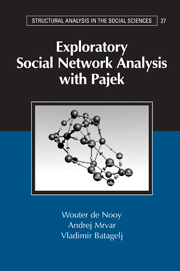Book contents
- Frontmatter
- Contents
- List of Illustrations
- List of Tables
- Preface
- Part I Fundamentals
- 1 Looking for Social Structure
- 2 Attributes and Relations
- Part II Cohesion
- Part III Brokerage
- Part IV Ranking
- Part V Roles
- Appendix 1 Getting Started with Pajek
- Appendix 2 Exporting Visualizations
- Appendix 3 Shortcut Key Combinations
- Glossary
- Index of Pajek Commands
- Subject Index
2 - Attributes and Relations
Published online by Cambridge University Press: 05 June 2012
- Frontmatter
- Contents
- List of Illustrations
- List of Tables
- Preface
- Part I Fundamentals
- 1 Looking for Social Structure
- 2 Attributes and Relations
- Part II Cohesion
- Part III Brokerage
- Part IV Ranking
- Part V Roles
- Appendix 1 Getting Started with Pajek
- Appendix 2 Exporting Visualizations
- Appendix 3 Shortcut Key Combinations
- Glossary
- Index of Pajek Commands
- Subject Index
Summary
Introduction
In Chapter 1, we argued that social network analysis focuses on social relations. A network is a set of vertices and lines. Both vertices and lines have characteristics that we may want to include in our analysis (e.g., the gender of people and the strength of their ties). As noted in Chapter 1, properties of relations are represented by line values in the network (e.g., first and second choices among girls in the dormitory). Now, we add characteristics of the vertices to the analysis. How can we use information on the actors to make sense of the social network?
In this chapter, we present techniques that combine relational network data and nonrelational attributes, such as psychological, social, economical, and geographical characteristics of the vertices in the network. The attributes enhance our interpretation of network structure and they enable us to study subsections of the network. In addition, we briefly discuss how to use the network position of vertices in statistical analysis; social network analysis and statistics are two complementary sets of techniques. After having studied this chapter, you will understand the basic data used in network analysis and you will be able to combine relational and nonrelational data.
- Type
- Chapter
- Information
- Exploratory Social Network Analysis with Pajek , pp. 29 - 58Publisher: Cambridge University PressPrint publication year: 2005



